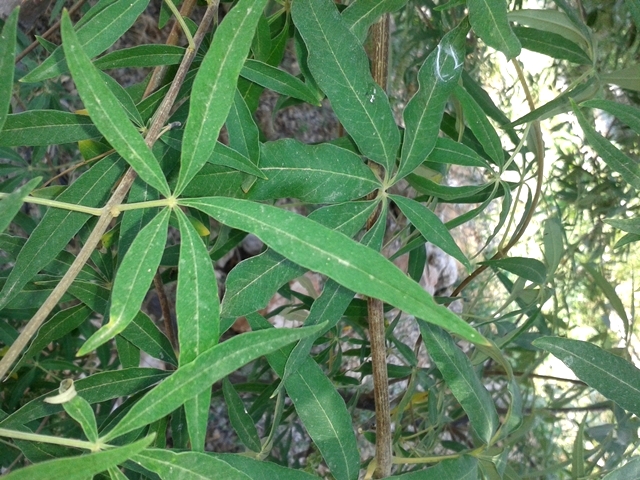Vitex agnus-castus (Chaste Tree, Vitex, Monk's Pepper)
Chastetree is a fast-growing, small tree or large shrub native to southern Europe and western Asia. The sage-scented gray-green leaves of Chastetree are shaped liked a hand, or palmate, and were once believed to have sedative effects. The flower is fragrant, lavender blooms upwardly-pointing, placed in terminal panicles and quite attractive to butterflies and bees. The tree is often planted where honey is marketed to promote excellent honey production. Blooms in the summertime. Chastetree likes sunny location with well-drained soil. It thrives in heat and blooms on new growth from the current season, so it can be pruned in spring if need be. In warm regions, it can be shaped into a small, single or multi-trunked tree. In cooler zones, chastetree grows as a modest-sized perennial shrub because it gets knocked back by extreme cold. Vitex agnus-castus will self-sow and can be invasive. It is advisable to cut back spent flowers in areas where seedlings can be problematic. Chastetree is used effectively in the mixed shrubbery border or as a specimen.
- Landscape Information
- Botanical Description
- Horticulture Management
-
By Sten Porse (Own photo, taken near Pont-du-Gard, Provence.) [GFDL (http://www.gnu.org/copyleft/fdl.html), CC-BY-SA-3.0 (http://creativecommons.org/licenses/by-sa/3.0/) or CC-BY-SA-2.5-2.0-1.0 (http://creativecommons.org/licenses/by-sa/2.5-2.0-1.0)], via Wikimedia Commons
-
By KENPEI (KENPEIs photo) [GFDL (http://www.gnu.org/copyleft/fdl.html), CC-BY-SA-3.0 (http://creativecommons.org/licenses/by-sa/3.0/) or CC-BY-SA-2.1-jp (http://creativecommons.org/licenses/by-sa/2.1/jp/deed.en)], via Wikimedia Commons
-
By H. Zell (Own work) [GFDL (http://www.gnu.org/copyleft/fdl.html) or CC-BY-SA-3.0 (http://creativecommons.org/licenses/by-sa/3.0)], via Wikimedia Commons
-
-
By H. Zell (Own work) [GFDL (http://www.gnu.org/copyleft/fdl.html) or CC-BY-SA-3.0 (http://creativecommons.org/licenses/by-sa/3.0)], via Wikimedia Commons
-
By H. Zell (Own work) [GFDL (http://www.gnu.org/copyleft/fdl.html) or CC-BY-SA-3.0 (http://creativecommons.org/licenses/by-sa/3.0)], via Wikimedia Commons
Search plant on Google
Download as PDF
-
French Name: Gattilier, Arbre au poivre, Agneau-chaste
Pronunciation: VY-teks AG-nus KAS-tus
-
Plant type: Shrub
-
Origin: Southern Europe, Mediterranean, Western Asia
-
Heat Zones: 6 to 16
Hardiness Zones: 6 to 12
-
Uses: Specimen, Container, Windbreak, Medicinal, Wildlife, Pollution Tolerant / Urban
-
Size/Shape
Growth Rate: Fast
Tree Shape: Round
Canopy Symmetry: Irregular
Canopy Density: Medium
Canopy Texture: Fine
Height at Maturity: 3 to 5 m
Spread at Maturity: 1.5 to 3 meters
Time to Ultimate Height: 2 to 5 Years
-
Notes
In alternative medicines it is believed the berries are a tonic herb for both the male and female reproductive system. The leaves are believed to have the same effect but to a lesser degree.
-
By Sten Porse (Own photo, taken near Pont-du-Gard, Provence.) [GFDL (http://www.gnu.org/copyleft/fdl.html), CC-BY-SA-3.0 (http://creativecommons.org/licenses/by-sa/3.0/) or CC-BY-SA-2.5-2.0-1.0 (http://creativecommons.org/licenses/by-sa/2.5-2.0-1.0)], via Wikimedia Commons
-
By KENPEI (KENPEIs photo) [GFDL (http://www.gnu.org/copyleft/fdl.html), CC-BY-SA-3.0 (http://creativecommons.org/licenses/by-sa/3.0/) or CC-BY-SA-2.1-jp (http://creativecommons.org/licenses/by-sa/2.1/jp/deed.en)], via Wikimedia Commons
-
By H. Zell (Own work) [GFDL (http://www.gnu.org/copyleft/fdl.html) or CC-BY-SA-3.0 (http://creativecommons.org/licenses/by-sa/3.0)], via Wikimedia Commons
-
-
By H. Zell (Own work) [GFDL (http://www.gnu.org/copyleft/fdl.html) or CC-BY-SA-3.0 (http://creativecommons.org/licenses/by-sa/3.0)], via Wikimedia Commons
-
By H. Zell (Own work) [GFDL (http://www.gnu.org/copyleft/fdl.html) or CC-BY-SA-3.0 (http://creativecommons.org/licenses/by-sa/3.0)], via Wikimedia Commons
Search plant on Google
Download as PDF
-
Foliage
Leaf Arrangement : Opposite
Leaf Venation: Pinnate
Leaf Persistance: Deciduous
Leaf Type: Palmately Compound
Leaf Blade: Less than 5
Leaf Margins: Entire
Leaf Texture: Smooth
Leaf Scent: Pleasant (Spicy, Bitter)
Color(growing season): Green
Color(changing season): Yellow
-
Flower
Flower Size Range: 10 - 20
Flower Type: Raceme
Flower Sexuality: Monoecious (Bisexual)
Flower Scent: Pleasant
Flower Color: Purple
Seasons: Spring, Summer
-
Trunk
Trunk Susceptibility to Breakage: Suspected to breakage
Number of Trunks: Can be trained to one trunk
Trunk esthetic Values: Not Showy
-
Fruit
Fruit Type: Berry
Fruit Size Range: 0 - 1.5, 1.5 - 3
Fruit Color: Brown
Seasons: Spring, Summer
-
By Sten Porse (Own photo, taken near Pont-du-Gard, Provence.) [GFDL (http://www.gnu.org/copyleft/fdl.html), CC-BY-SA-3.0 (http://creativecommons.org/licenses/by-sa/3.0/) or CC-BY-SA-2.5-2.0-1.0 (http://creativecommons.org/licenses/by-sa/2.5-2.0-1.0)], via Wikimedia Commons
-
By KENPEI (KENPEIs photo) [GFDL (http://www.gnu.org/copyleft/fdl.html), CC-BY-SA-3.0 (http://creativecommons.org/licenses/by-sa/3.0/) or CC-BY-SA-2.1-jp (http://creativecommons.org/licenses/by-sa/2.1/jp/deed.en)], via Wikimedia Commons
-
By H. Zell (Own work) [GFDL (http://www.gnu.org/copyleft/fdl.html) or CC-BY-SA-3.0 (http://creativecommons.org/licenses/by-sa/3.0)], via Wikimedia Commons
-
-
By H. Zell (Own work) [GFDL (http://www.gnu.org/copyleft/fdl.html) or CC-BY-SA-3.0 (http://creativecommons.org/licenses/by-sa/3.0)], via Wikimedia Commons
-
By H. Zell (Own work) [GFDL (http://www.gnu.org/copyleft/fdl.html) or CC-BY-SA-3.0 (http://creativecommons.org/licenses/by-sa/3.0)], via Wikimedia Commons
Search plant on Google
Download as PDF
-
Tolerance
Frost Tolerant: Yes
Heat Tolerance: Yes
Salt Tolerance: Good
-
Requirements
Soil Requirements: Clay, Loam, Sand
Soil Ph Requirements: Acidic, Neutral, Alkaline
Water Requirements: Moderate, Low
Light Requirements: Full
-
Management
Toxicity: Yes
Susceptibility to Pests and Diseases: No
Pruning Requirements: Needed, to develop a strong structure
Fruit/ Leaves/ Flowers litter: No
Life Span: Less than 25
Plant Propagation: Seed, Cutting

